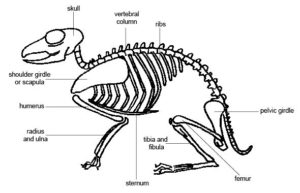Back Pain in Animals
Did you ever wonder about back pain in animals? We already know that a large percentage of the human population has experienced back pain over their lifetime. So, it makes sense that animals experience back pain as well. Let’s take a look at some of our four-legged friends and their back pain.
The Spine in Humans and Animals
Evolutionists say that humans evolved from animals that walked on 4 legs. Some surmise that the prevalence of lower back pain stems from the fact that our spines have not evolved enough to support our upper body’s weight. However, this cannot be the only cause of our problems, because…animals get back pain too.
Animals’ Spinal Anatomy

Source: Wikipedia
All animals within the subphylum Vertebrate have a spine. The exact structure and specifics of the spinal column varies from one species to another but the general makeup and function are the same. In other words, animals that have a spine have:
- vertebrae (bones in the spine)
- discs (soft material between the bones, acting as shock absorbers)
- ligaments (to hold the vertebrae together)
- a spinal cord running through it1
See Also: The Anatomy of the Spine
Back Pain in Animals
Given the anatomy of the spine in other animals is similar to that of humans, it’s no surprise that other animals can experience some of the same back problems as humans. They can, however, display their pain and symptoms in different ways than you or I would. Let’s take a look at back pain in animals.
Dog Back Pain
Back pain in dogs can be a result of disease, injury or simply age (ie: disc degeneration). In addition, a kidney infection, cancer or infection from a bite can cause back pain in dogs.
How can you tell if your dog has back pain? Dogs experiencing back pain may show a change in posture, have a hunched back, a reluctance to move their head (due to a stiff neck), cry out when their back/spine is touched, appear to be lethargic and/or have a reduced appetite.3
Because of the numerous potential causes for back pain in dogs, determining the underlying reason may be difficult. In addition, your dog can’t communicate exactly where they’re experiencing pain. Your veterinarian may be able to determine the cause through physical examination, but it could require diagnostic testing such as: blood tests, CT scan, X-ray or MRI.2
Treatment for back pain in dogs can vary as much as it does for humans. Depending on the cause, your veterinarian could recommend medication such as an anti-inflammatory or steroid injection. In more serious cases, surgery may be required.
Back Pain in Horses
 The race track is open here in Saratoga and there are horses everywhere. Most race horses are in good shape from the regular exercise but some may still experience spine problems and back pain.
The race track is open here in Saratoga and there are horses everywhere. Most race horses are in good shape from the regular exercise but some may still experience spine problems and back pain.
Just like with humans and other animals, back pain in horses can result from injury, disease or the normal aging process. However, horseshoes, saddles and other riding equipment can also lead to back pain in horses if not fitted properly.4
Each horse may display back pain symptoms differently so it is often difficult to diagnose a spine problem. In fact, poor riding performance (not a display of pain) is often what leads someone to have their horse evaluated.5
Because back pain in horses is so difficult to diagnose it’s best to have your horse evaluated by a certified equine chiropractor or veterinarian if you think he or she is experiencing back pain.
References
